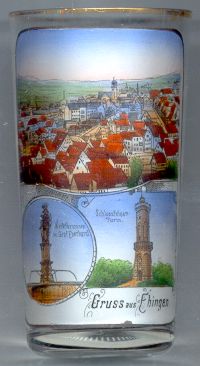

|
| DEUTSCHLAND | GERMANY |
| Bundesland: Baden-Württemberg | |
| Regierungsbezirk: Tübingen | |
| Landkreis: Zollernalbkreis |
 Albstadt is situated at an elevation of 861 m on the river Schmiecha in the southwestern Alb region
about 35 km south of Tübingen.
The settlement was founded in the 4th or 5th century. The first mention of Ebingen in a document dates from 793.
During the early Middle Ages the village became a regional centre and the seat of a church chapter or deanery.
The counts of Hohenberg granted Ebingen the status of a town around 1260; the first document to this effect dates from 1285.
In 1367 Ebingen came in possession of Württemberg, at first as a pawn, and 1468 as a definite property.
Textile manufactures existed here at least since the 17th century, but when the first steam engines were introduced in 1834 the
textile industry boomed and became a major factor for the town's economy. In 1956 Ebingen reached a population of 20,000 and thus
received the status of a 'major district town'.
In 1971/1972 Margrethausen, Lautlingen, and Laufen were incorporated into Ebingen.
The towns of Ebingen and Tailfingen (with Truchtelfingen), and the communities of Onstmettingen and Pfeffingen
were merged in 1975 into a single municipality which took the new name, Albstadt. With 49,000 inhabitants Albstadt is the
largest town in the Zollernalb district.
Albstadt is situated at an elevation of 861 m on the river Schmiecha in the southwestern Alb region
about 35 km south of Tübingen.
The settlement was founded in the 4th or 5th century. The first mention of Ebingen in a document dates from 793.
During the early Middle Ages the village became a regional centre and the seat of a church chapter or deanery.
The counts of Hohenberg granted Ebingen the status of a town around 1260; the first document to this effect dates from 1285.
In 1367 Ebingen came in possession of Württemberg, at first as a pawn, and 1468 as a definite property.
Textile manufactures existed here at least since the 17th century, but when the first steam engines were introduced in 1834 the
textile industry boomed and became a major factor for the town's economy. In 1956 Ebingen reached a population of 20,000 and thus
received the status of a 'major district town'.
In 1971/1972 Margrethausen, Lautlingen, and Laufen were incorporated into Ebingen.
The towns of Ebingen and Tailfingen (with Truchtelfingen), and the communities of Onstmettingen and Pfeffingen
were merged in 1975 into a single municipality which took the new name, Albstadt. With 49,000 inhabitants Albstadt is the
largest town in the Zollernalb district.
The bottom left picture shows the
 Marktbrunnen
Marktbrunnen
The  Schlossfelsenturm [bottom right]
is located at an elevation of 952 m on the Schlossfels mountain near Ebingen. The lookout tower
was built in 1899 marks the site of a medieval castle of the 12th/13th century.
Schlossfelsenturm [bottom right]
is located at an elevation of 952 m on the Schlossfels mountain near Ebingen. The lookout tower
was built in 1899 marks the site of a medieval castle of the 12th/13th century.
Claus Schenk Graf von Stauffenberg (1907–1944), leading figure of the failed assassination of Adolf Hitler in 1944,
spent his youth at his family's estate in Albstadt-Lautlingen.
![[scale]](lineal.jpg)